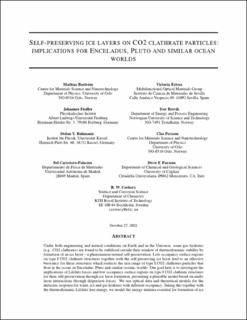| dc.contributor.author | Boström, Mathias | |
| dc.contributor.author | Esteso, Victoria | |
| dc.contributor.author | Fiedler, Johannes | |
| dc.contributor.author | Brevik, Iver Håkon | |
| dc.contributor.author | Persson, Clas | |
| dc.contributor.author | Buhmann, Stefan Yoshi | |
| dc.contributor.author | Carretero-Palacios, Sol | |
| dc.contributor.author | Parsons, Drew F. | |
| dc.contributor.author | Corkery, Robert W. | |
| dc.date.accessioned | 2021-11-04T11:24:39Z | |
| dc.date.available | 2021-11-04T11:24:39Z | |
| dc.date.created | 2021-06-14T11:54:19Z | |
| dc.date.issued | 2021 | |
| dc.identifier.citation | Astronomy and Astrophysics (A & A). 2021, 650 . | en_US |
| dc.identifier.issn | 0004-6361 | |
| dc.identifier.uri | https://hdl.handle.net/11250/2827830 | |
| dc.description.abstract | Context. Gas hydrates can be stabilised outside their window of thermodynamic stability by the formation of an ice layer – a phenomenon termed self-preservation. This can lead to a positive buoyancy for clathrate particles containing CO2 that would otherwise sink in the oceans of Enceladus, Pluto, and similar oceanic worlds.
Aims. Here we investigate the implications of Lifshitz forces and low occupancy surface regions on type I clathrate structures for their self-preservation through ice layer formation, presenting a plausible model based on multi-layer interactions through dispersion forces.
Methods. We used optical data and theoretical models for the dielectric response for water, ice, and gas hydrates with a different occupancy. Taking this together with the thermodynamic Lifshitz free energy, we modelled the energy minima essential for the formation of ice layers at the interface between gas hydrate and liquid water.
Results. We predict the growth of an ice layer between 0.01 and 0.2 μm thick on CO, CH4, and CO2 hydrate surfaces, depending on the presence of surface regions depleted in gas molecules. Effective hydrate particle density is estimated, delimiting a range of particle size and compositions that would be buoyant in different oceans. Over geological time, the deposition of floating hydrate particles could result in the accumulation of kilometre-thick gas hydrate layers above liquid water reservoirs and below the water ice crusts of their respective ocean worlds. On Enceladus, the destabilisation of near-surface hydrate deposits could lead to increased gas pressures that both drive plumes and entrain stabilised hydrate particles. Furthermore, on ocean worlds, such as Enceladus and particularly Pluto, the accumulation of thick CO2 or mixed gas hydrate deposits could insulate its ocean against freezing. In preventing freezing of liquid water reservoirs in ocean worlds, the presence of CO2-containing hydrate layers could enhance the habitability of ocean worlds in our Solar System and on the exoplanets and exomoons beyond. | en_US |
| dc.language.iso | eng | en_US |
| dc.publisher | European Southern Observatory (ESO) | en_US |
| dc.title | Self-preserving ice layers on CO2 clathrate particles: Implications for Enceladus, Pluto, and similar ocean worlds | en_US |
| dc.type | Peer reviewed | en_US |
| dc.type | Journal article | en_US |
| dc.description.version | acceptedVersion | en_US |
| dc.rights.holder | This is the authors' manuscript to an article published by European Southern Observatory (ESO) and EDP Sciences | en_US |
| dc.source.pagenumber | 10 | en_US |
| dc.source.volume | 650 | en_US |
| dc.source.journal | Astronomy and Astrophysics (A & A) | en_US |
| dc.identifier.doi | 10.1051/0004-6361/202040181 | |
| dc.identifier.cristin | 1915550 | |
| cristin.ispublished | true | |
| cristin.fulltext | postprint | |
| cristin.qualitycode | 2 | |
